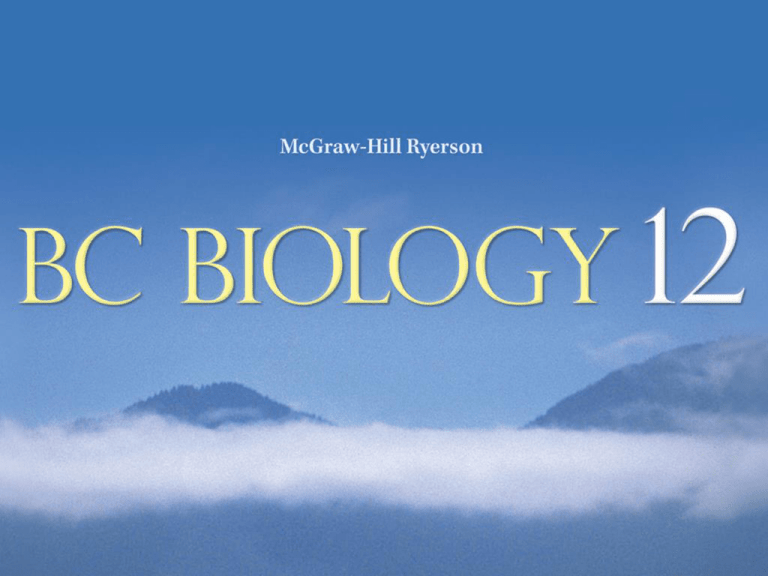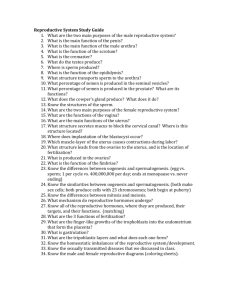Chapter 14: Reproductive System
advertisement

UNIT B: Human Body Systems Chapter 8: Human Organization Chapter 9: Digestive System Chapter 10: Circulatory System and Lymphatic System Chapter 11: Respiratory System Chapter 12: Nervous System Chapter 13: Urinary System Chapter 14: Reproductive System: Section 14.1 UNIT B Chapter 14: Reproductive System Chapter 14: Reproductive System In this chapter you will learn about the male and female reproductive systems, the ovarian and uterine cycles, and disorders of the reproductive systems. What different events must occur before fertilization? What is the function of the umbilical cord? TO PREVIOUS SLIDE Cord blood banking. Cord blood can be used to treat diseases such as leukemia, lymphoma, and other blood and immune system disorders. After an umbilical cord blood sample is collected, it is stored in a cord blood bank. There are both private and public banks. UNIT B Chapter 14: Reproductive System Section 14.1 14.1 Male Reproductive System Organisms that carry out sexual reproduction produce gametes, haploid sex cells that are united during fertilization. • In the male reproductive system, the sperm are gametes that are produced in paired testes (male gonads) o Seminal fluid: a nutrient-rich fluid in which sperm leave the penis during ejaculation o Semen: combination of sperm and seminal fluid TO PREVIOUS SLIDE UNIT B Chapter 14: Reproductive System TO PREVIOUS SLIDE Section 14.1 Figure 14.1 The male reproductive system. The testes produce sperm. The seminal vesicles, the prostate gland, and the bulbourethral glands provide a fluid medium for the sperm, which move from the vasa deferentia through the ejaculatory ducts to the urethra in the penis. UNIT B Chapter 14: Reproductive System Section 14.1 Genital Tract • Testes: paired structures that produce sperm and sex hormones • Epididymides: ducts outside the testes where sperm mature and are stored • Vas deferens: stores sperm; empties into an ejaculatory duct TO PREVIOUS SLIDE UNIT B Chapter 14: Reproductive System • Urethra: connected to the ejaculatory duct • Seminal vesicles: contribute nutrients and fluids to semen • Prostate gland: contributes basic solution to semen (sperm are more viable in a basic solution) • Cowper’s glands: secrete a mucus-rich fluid that helps lubricate the penis TO PREVIOUS SLIDE Section 14.1 UNIT B Chapter 14: Reproductive System Section 14.1 • Penis: male organ of sexual intercourse o Circumcision: surgical removal of the foreskin TO PREVIOUS SLIDE Figure 14.2 Penis anatomy. a. Beneath the skin and the connective tissue lies the urethra, surrounded by erectile tissue. This tissue expands to form the glans penis, which in uncircumcised males is partially covered by the foreskin (prepuce). b. Two other columns of erectile tissue in the penis are located dorsally. UNIT B Chapter 14: Reproductive System TO PREVIOUS SLIDE Section 14.1 UNIT B Chapter 14: Reproductive System Section 14.1 Erection and Orgasm in Males Erection • Erectile tissue extends throughout the shaft of the penis • Sexual excitement causes the arteries in the penis to relax and widen • Increased blood flow causes the penis to enlarge and become erect Figure 14.2 Penis anatomy. b. Two other columns of erectile tissue in the penis are located dorsally. TO PREVIOUS SLIDE UNIT B Chapter 14: Reproductive System Section 14.1 Ejaculation and Orgasm • When sexual stimulation intensifies, sperm enter the urethra from the vasa deferentia and the accessory glands contribute secretions to the semen • Rhythmic muscle contractions cause semen to be ejaculated from the penis o These contractions are part of male orgasm (climax of sexual stimulation) • A refractory period occurs after ejaculation, where sexual stimulation does not cause an erection • More than 400 million sperm are expelled in 2 to 6 mL of semen during ejaculation TO PREVIOUS SLIDE UNIT B Chapter 14: Reproductive System Section 14.1 Male Gonads, the Testes Testes • Lie within the scrotum • The scrotum helps regulate testicular temperature by holding the testes closer or farther away from the body • Increases in temperature may decrease sperm production TO PREVIOUS SLIDE Figure 14.3 Testis and sperm. a. The lobules of a testis contain seminiferous tubules. UNIT B Chapter 14: Reproductive System Section 14.1 Seminiferous Tubules • A testis is composed of lobules, each of which contains tightly coiled seminiferous tubules • Intersitial cells that lie between the tubules secrete male sex hormones (androgens) • Seminiferous tubules contain cells undergoing spermatogenesis (production of sperm) TO PREVIOUS SLIDE Figure 14.3 Testis and sperm. b. Light micrographs of a cross section of the seminiferous tubules, where spermatogenesis occurs. Note the location of interstitial cells in clumps among the seminiferous tubules. UNIT B Chapter 14: Reproductive System TO PREVIOUS SLIDE Section 14.1 Figure 14.3 Testis and sperm. a. The lobules of a testis contain seminiferous tubules. b. Light micrographs of a cross section of the seminiferous tubules, where spermatogenesis occurs. Note the location of interstitial cells in clumps among the seminiferous tubules. UNIT B Chapter 14: Reproductive System Section 14.1 Spermatogenesis • Occurs in the walls of the seminiferous tubules • Spermatogonia become primary spermatocytes that undergo meiosis I to produce secondary spermatocytes • Secondary spermatocytes undergo meiosis II to produce four haploid spermatids • Spermatids differentiate into sperm • Sertoli cells support, nourish, and regulate the spermatogenic cells TO PREVIOUS SLIDE UNIT B Chapter 14: Reproductive System TO PREVIOUS SLIDE Figure 14.3 Testis and sperm. c. Diagrammatic representation of spermatogenesis, which occurs in the walls of the tubules. Section 14.1 UNIT B Chapter 14: Reproductive System Section 14.1 Sperm • Mature sperm (spermatozoa) have a head, middle piece, and a tail • Mitochondria in the middle piece is the site of ATP production for the movement of the tail • The acrosome is a cap that stores enzymes needed to penetrate the egg • The nucleus of the sperm has the male’s DNA as 23 chromosomes • Sperm usually do not live more than 48 hours in the female genital tract TO PREVIOUS SLIDE Figure 14.3 Testis and sperm. d. A sperm has a head, a middle piece, tail, and an end piece. The nucleus is in the head, which is capped by the enzyme-containing acrosome. UNIT B Chapter 14: Reproductive System Section 14.1 Hormonal Regulation in Males Hypothalamus controls secretions of the pituitary gland by secreting gonadotropin-releasing hormone (GnRH). • GnRH: stimulates the pituitary gland to release folliclestimulating hormone (FSH) and luteinizing hormone (LH) o FSH: promotes sperm production in the seminiferous tubules (which secrete inhibin, a hormone which inhibits FSH synthesis) o LH: also called interstitial-cell-stimulating hormone (ICSH) because it promotes the production of testosterone by interstitial cells TO PREVIOUS SLIDE UNIT B Chapter 14: Reproductive System Figure 14.4 Hormonal control of testes. GnRH stimulates the anterior pituitary to produce FSH and LH. FSH stimulates the testes to produce sperm, and LH stimulates the testes to produce testosterone. Testosterone from interstitial cells and inhibin from the seminiferous tubules exert negative feedback control over the hypothalamus and the anterior pituitary, and this ultimately regulates the level of testosterone in the blood. TO PREVIOUS SLIDE Section 14.1 UNIT B Chapter 14: Reproductive System Section 14.1 Testosterone • The main sex hormone in males • Essential for normal development and functioning of male reproductive structures • Maintains male secondary sex characteristics that develop at puberty (body hair, deeper voices, greater muscular development) TO PREVIOUS SLIDE UNIT B Chapter 14: Reproductive System Check Your Progress 1. Compare the functions of the seminiferous tubules, interstitial cells, epididymis, vasa deferentia, and urethra. 2. List the three glands that add secretions to semen. 3. Explain the roles of GnRH, FSH, ICSH and testosterone in male reproduction. TO PREVIOUS SLIDE Section 14.1 UNIT B Chapter 14: Reproductive System TO PREVIOUS SLIDE Section 14.1 UNIT B Chapter 14: Reproductive System TO PREVIOUS SLIDE Section 14.1 UNIT B Chapter 14: Reproductive System TO PREVIOUS SLIDE Section 14.1 UNIT B Chapter 14: Reproductive System TO PREVIOUS SLIDE Section 14.1





